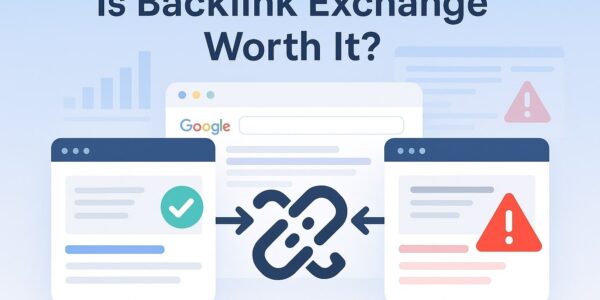In 2025, backlink exchanges can still improve your SEO, but only if done carefully and for the right reasons. Some swaps support rankings when links are earned naturally. Others, especially those that look manipulative or irrelevant, may lead to penalties from Google.
This guide explains when backlink exchanges are safe, how Google evaluates them today, and which smarter strategies to use instead.
What Is Backlink Exchange? Types & Modern Examples
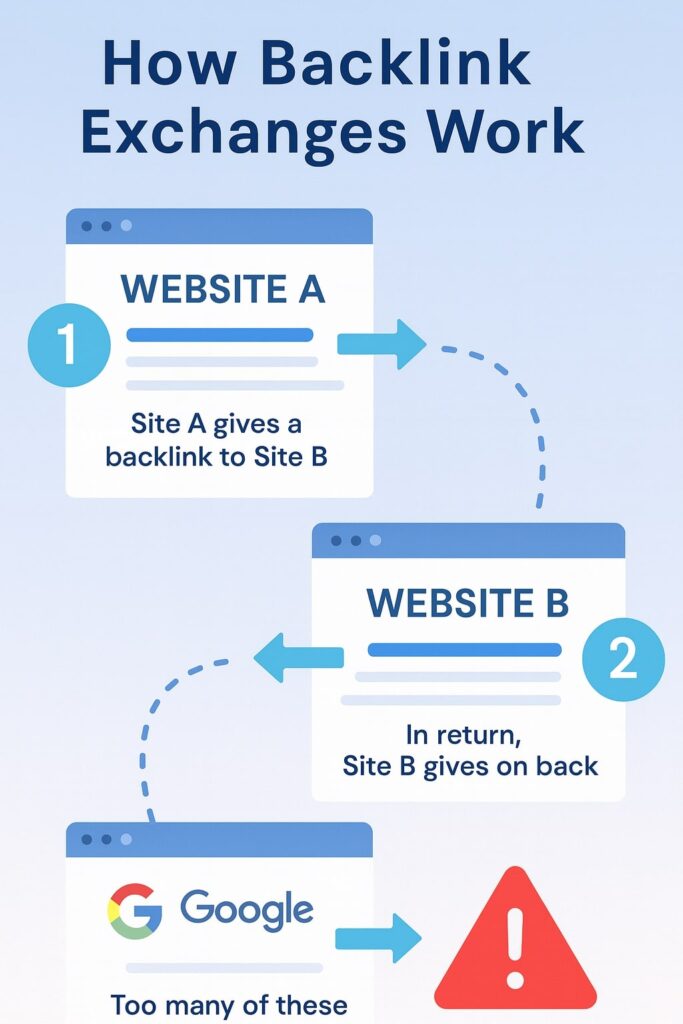
Backlink exchange is when two or more websites agree to link to each other to improve search engine rankings. It’s a long-used SEO tactic, but in 2025, it’s under greater scrutiny due to algorithm updates like Google’s SpamBrain. While exchanges still happen, the way they are structured and the intent behind them now play a major role in how Google evaluates them.
Some link exchanges are natural and editorially sound—others are purely transactional and risk being flagged as spam. Understanding the difference is key to avoiding penalties while still benefiting from this strategy.
Here are the three most common types of backlink exchanges used today, along with examples of how they work and the risks involved:
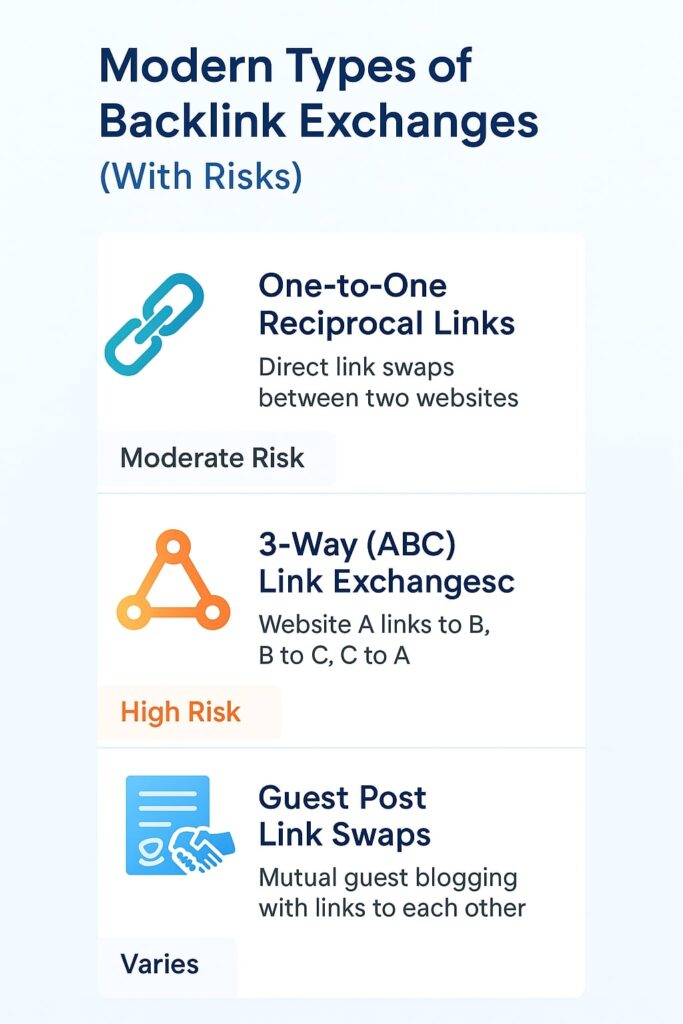
- One-to-One Reciprocal Links
- 3-Way (ABC) Link Exchanges
- Guest Post Link Swaps
Let’s explore each one to understand when they help—and when they can hurt—your SEO.
1) Reciprocal Backlinks: Natural or Spammy?
A reciprocal backlink happens when two websites agree to link to each other. This is still a common practice in 2025. It can happen naturally, like when two brands mention each other’s helpful content,or through planned link exchanges. Whether this helps or hurts your SEO depends on how relevant and genuine the exchange is.
When Reciprocal Links Are Safe
Reciprocal links are acceptable when they are earned honestly and serve the reader. These types of links are usually safe:
- Both sites focus on related topics or industries
- The links are placed inside useful, original articles—not in ads or widgets
- The exchanges don’t happen too often or follow a repeating pattern
- Anchor text (the clickable text) is written naturally, not stuffed with keywords
- There’s a real reason for linking, such as expert collaboration or useful citations
Example: A nutrition blog writes an article on healthy eating and links to a fitness brand’s guide on exercises. Later, the fitness site shares a blog post linking back to the nutrition blog’s recipe. This kind of linking is logical, helpful, and user-friendly.
According to Ahrefs, 73.6% of high-ranking pages have some reciprocal links. This shows that mutual links are not automatically spam, as long as they are relevant and not overused.
When Reciprocal Links Become Spam
Problems start when websites use reciprocal links only to boost SEO rankings—without adding value. Google’s SpamBrain algorithm now checks for patterns that suggest manipulation.
Risky signs include:
- Linking repeatedly with the same partner
- Adding links to unrelated or low-quality websites
- Using exact-match keywords as anchor text (e.g., “buy cheap shoes”)
- Linking from unhelpful places like footers or sidebars
- Doing fast exchanges without quality content or proper editorial review
In its latest Search Essentials, Google clearly warns against “excessive link exchanges.” Google’s John Mueller has also said that planned or unnatural link trades violate their quality guidelines.
If Google sees many matched links between two sites using the same text or placed around the same time, it may ignore or penalize those links.
Best practice:
Ask yourself, “Would I still include this link if SEO didn’t matter?”
If your answer is no, the link may not be worth it.
2) 3-Way Link Swaps: Safer but Still Risky in 2025
A 3-way link swap—also called a triangular link exchange—is when three websites link to each other in a loop to avoid a direct link-for-link trade. It’s designed to appear more natural and reduce the risk of detection by Google.
Example (Triangular Pattern):
- Site A links to Site B
- Site B links to Site C
- Site C links back to Site A
At no point do two sites link directly to each other. But when you look at all three together, it still creates a closed loop. This pattern is commonly used in SEO to hide the fact that the links are part of an exchange. In most cases, all three sites agree to this setup in advance, which makes the links less organic and more likely to be flagged by algorithms. These links often lack editorial independence, which is one of the key signals Google uses to assess link quality.
Why People Use 3-Way Link Swaps
- They’re harder to detect than direct link exchanges.
- The links can be spread out over time.
- Agencies often use them to make backlink profiles look more “natural.”
- Some marketers believe this structure is safer because it avoids obvious reciprocation, but that’s not always true.
- These links allow for more flexibility in choosing partners, especially when websites operate in overlapping but not identical niches.
- 3-way swaps are often used in outreach templates where multiple webmasters collaborate to rotate links across multiple domains.
- Because no two websites are linking to each other directly, it’s harder for competitors to spot the connection without deep analysis.
- This method became more common after Google began targeting obvious reciprocal link patterns in manual actions and algorithmic updates.
Why They’re Still Risky in 2025
- Google’s SpamBrain and link graph algorithms can detect triangular link loops.
- If websites use similar anchors or publish links close together in time, it leaves a footprint.
- If the links are made only to improve rankings, they may be devalued or penalized.
- Even if there’s no penalty, these links may pass little or no SEO value if the system identifies them as unnatural.
- When Google notices a network of sites repeatedly linking to each other in circular patterns, it may downgrade trust signals.
- If even one site in the triangle is low-quality or spammy, it can negatively affect the others.
- These swaps often lack editorial context, which reduces their authority and natural appearance.
- In 2025, link manipulation patterns are more easily identified due to advanced pattern-recognition across domains, devices, and publishing networks.
According to Google’s official link spam policy, even indirect link exchanges can be considered spam if they are done to pass PageRank unnaturally.
How to Use This Strategy More Safely
- Choose relevant websites within your industry or niche.
- Link through helpful, high-quality content—not thin or promotional pages.
- Avoid timing patterns—space the links over weeks, not days.
- Personalize outreach—avoid mass email swaps or link groups.
- Use this method sparingly—and combine it with other strategies like guest posting or content-led outreach.
- Confirm that each link exchange serves a clear informational purpose and not just SEO gain.
- Review backlink profiles regularly to ensure you’re not unintentionally forming detectable exchange networks.
- Avoid link schemes that involve multiple overlapping triangles, as these are easier for algorithms to flag
Triangular link swaps may avoid simple detection, but they are still part of Google’s link spam radar. If your links are truly editorial, relevant, and helpful, they may hold value. But if used purely for SEO gains, they risk being ignored—or worse, penalized.
Always prioritize content quality, relevance, and long-term trust over short-term SEO tricks. Focus on building relationships with publishers and editors, not just exchanging links. Sustainable link-building requires patience and strategic diversification, not shortcuts.
3)Guest Post Exchanges: Still Effective in Modern SEO?
Guest post exchanges—when two websites publish content for each other—can still help SEO in 2025, but only if done correctly. Google does not punish guest posting itself, but it does take action if the purpose is just to build links unnaturally. That’s why these exchanges must be based on quality content, useful information, and relevance to the audience.
How Guest Post Exchanges Work
In a typical guest post exchange, one website publishes a helpful article from another website. Later, the second website does the same. For example, a digital marketing blog might publish a guide from an SEO tools provider. Later, that SEO tools blog shares a piece about blog content tips from the same marketing site. Each article includes a natural, helpful backlink.
This is allowed when both websites offer value, stay relevant to each other’s audiences, and write high-quality content. The link should make sense for the reader, not just serve SEO purposes.
Why They Still Work in 2025
- Editorial Value: Each post should offer real advice, tips, or new information—not just be written to get a backlink.
- Niche Alignment: Both websites should cover similar topics. For example, an SEO site and a marketing blog are aligned; an SEO site and a recipe blog are not.
- Contextual Backlinks: The backlink should appear inside the article where it adds meaning—not just in the author bio or footer.
- Manual Approval: Editors should read and approve every guest post to keep quality high.
- Time Gap: Don’t publish the guest posts at the same time. Leave some space to avoid making the exchange too obvious.
These steps help your guest posts look natural and useful, which is what Google wants.
Common Pitfalls to Avoid
- Repeated Anchor Text: Using the same keyword in every post, like “best SEO tools,” makes it look like spam.
- Weak Content: Don’t use AI or low-effort articles. Each post should be written clearly and offer helpful info.
- Unrelated Swaps: Avoid working with sites in completely different fields. The audience won’t benefit, and Google may ignore the links.
- Copy-Paste Outreach: Don’t send the same email to 100 sites. Customize each message and explain why your article fits their blog.
Google checks for patterns. If they think your guest post is just for links, it won’t help—and might even harm your site.
Editorial Guidelines Matter More Than Ever
Google now expects websites to follow E-E-A-T—Expertise, Experience, Authoritativeness, and Trust. Guest posts that don’t meet these expectations might lower your credibility. Editors should check every submission, and the content should reflect real knowledge and original thinking. Guest posts must help readers first, not just add a backlink.
Final Takeaway
Guest post exchanges still work—but only when the focus is on value and quality. Write original, well-researched posts. Choose relevant sites. Don’t link just for SEO. Guest posting is still a white-hat tactic when it builds trust and helps real people.
What Google Really Says About Link Exchange in 2025
Google’s position on backlink exchange in 2025 remains consistent in principle, but enforcement is now far more advanced. The key issue isn’t just whether links were exchanged—but how they were created, why they exist, and what value they bring to users.
In the past, many link exchanges were manually penalized, especially during the Penguin era. Today, Google relies on SpamBrain, its AI-based link spam detection system, to evaluate links at scale. This algorithm examines not only the backlink itself but also link patterns, timing, anchor text use, and topical relevance between domains.
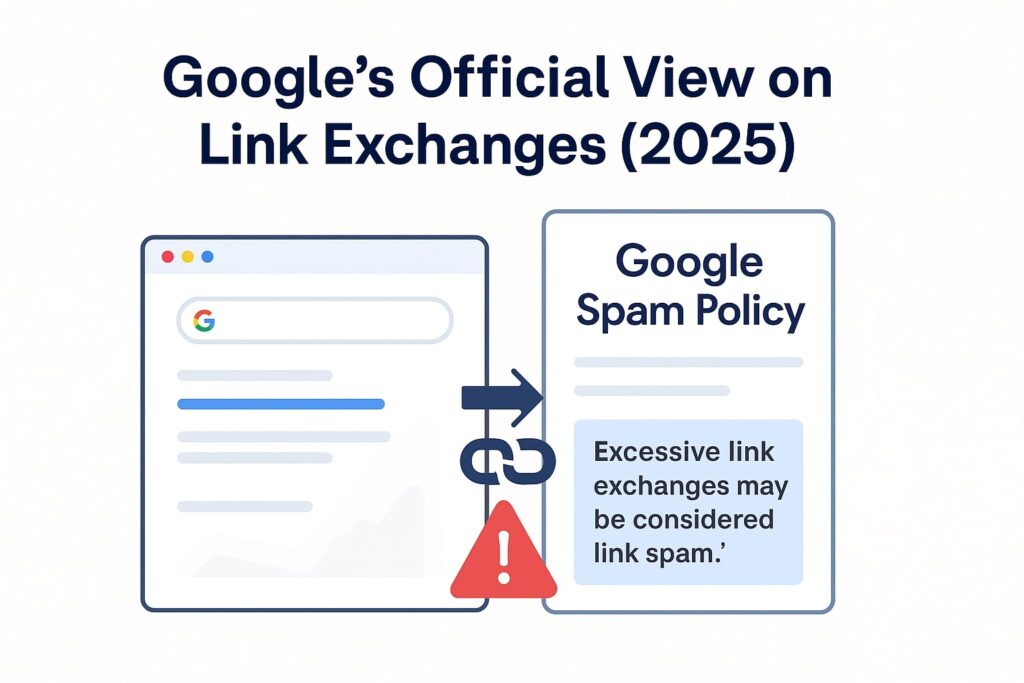
In the latest version of Google’s Link Spam Policy, link exchanges are flagged when they meet any of the following criteria:
- “Excessive link exchanges (‘Link to me and I’ll link to you’)”
- “Partner pages created only for cross-linking”
- “Links intended solely to manipulate PageRank”
However, not every link exchange is considered spam. Google makes it clear that editorial relevance, user benefit, and organic placement are more important than the existence of a mutual link.
Key Takeaway:
Google doesn’t penalize all backlink exchanges—but it does penalize manipulative ones. If your links are built purely for rankings, lack editorial oversight, or fail to serve readers, they risk devaluation or penalty.
Are All Link Exchanges Penalized by Google?
No, Google does not penalize all link exchanges—but it does scrutinize the intent and execution. If links are exchanged naturally between relevant, editorial sites, they may still be considered valid. However, excessive, manipulative, or spammy exchanges can trigger algorithmic devaluation or manual penalties.
What Triggers a Penalty?
Google flags link exchanges when it detects:
- Repetitive reciprocal patterns across the same domains.
- Unnatural anchor text used purely for ranking.
- Low editorial standards, especially in unrelated niches.
- Overuse of guest post swapping without value or variation.
Manual vs. Algorithmic Actions
- Manual penalties result from clear abuse and are flagged in Google Search Console.
- Algorithmic devaluation occurs silently—SpamBrain simply ignores suspicious links.
What Google Tolerates
Occasional exchanges between topically relevant, quality sites with clear editorial value are generally safe—especially if:
- Links are placed in useful, contextual content.
- There’s no obligation or pattern behind the exchange.
Takeaway: Most link exchanges aren’t penalized by default—but if you’re exchanging links to boost SEO rankings without user benefit, you’re at risk of being ignored or penalized.
Factors Google Evaluates Before Penalizing a Link Exchange
Google doesn’t penalize every link exchange—but it evaluates specific signals to decide whether a backlink is earned or manipulative. These signals are analyzed both at the page level and across the broader link graph.
1. Anchor Text Manipulation
Over-optimized anchor text—especially with exact-match keywords—signals intent to manipulate rankings. If every link uses the same keyword phrase, Google’s algorithm may flag it as unnatural.
As highlighted in Google’s Link Spam Policy, links that are created solely to pass PageRank are likely to be ignored or penalized.
2. Obvious Exchange Patterns
Repeated links between the same sites (A↔B or A→B→C→A) form detectable footprints. If several sites in a niche are all linking to each other in loops, it suggests coordination rather than editorial intent.
Google now uses link graph analysis and SpamBrain to detect these reciprocal structures at scale.
3. Unnatural Timing or Velocity
A sudden spike in backlinks—especially from similar domains or with matching anchors—raises red flags. Google prefers links to accumulate naturally over time, not through coordinated swaps.
Even if links are spread across different pages, identical publishing timelines can make exchanges appear manipulative.
4. Irrelevant or Off-Niche Linking
Linking to unrelated topics or industries dilutes topical relevance. For example, if an SEO blog links to a dog food site, Google sees no semantic connection—hurting the credibility of both.
Relevance remains a key ranking factor in 2025, especially for passing authority.
5. Link Placement and Density
If a page contains too many outbound links—especially in footers, sidebars, or stacked unnaturally in paragraphs—it may resemble a link farm. Google evaluates whether the link enhances content or just exists for SEO purposes.
Avoid placing multiple backlinks together with no contextual explanation.
✅ Safe Link Exchange Checklist
- ✔ Use descriptive, varied anchor text.
- ✔ Space links across time and pages.
- ✔ Choose niche-relevant partners.
- ✔ Keep links inside well-written, valuable content.
- ✔ Avoid linking to unrelated or spammy sites.
Final Thought:
Google doesn’t rely on any single metric. It examines patterns of linking behavior over time. One suspicious link may not hurt, but repeated misuse can lead to algorithmic suppression or manual action.
How to Do Backlink Exchange Safely & Strategically
Backlink exchanges can still work in 2025 — but only when handled carefully and with SEO best practices.
Google’s algorithms are now smart enough to detect manipulative or unnatural linking patterns. That means casual link swaps without context or editorial value may actually hurt your rankings, even if they come from high-DA websites.
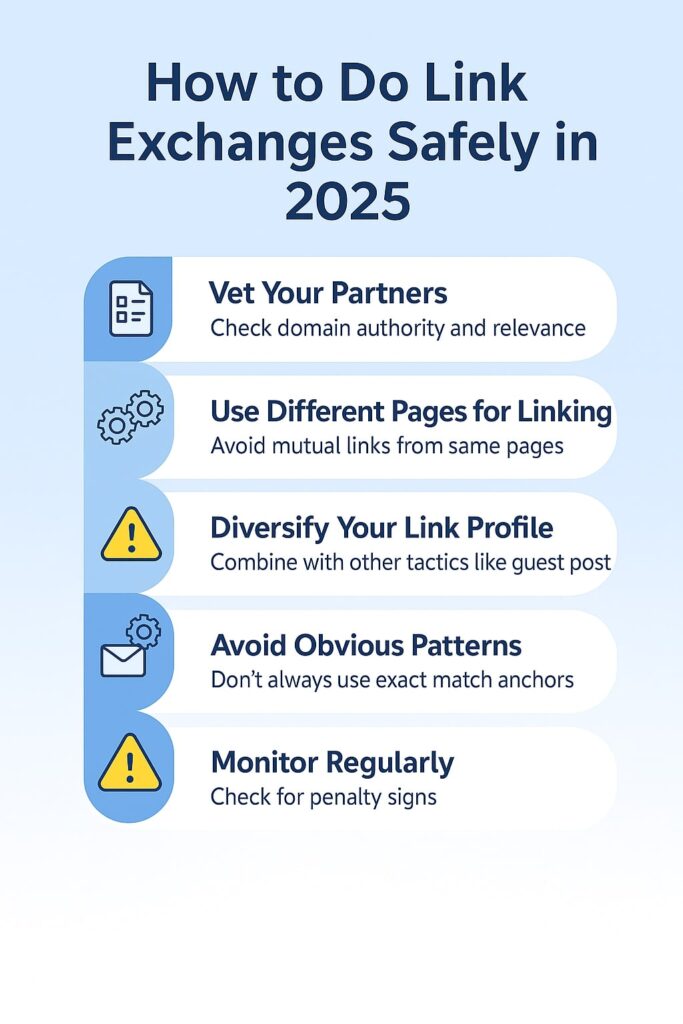
To stay safe, you need a smart and ethical strategy. This includes evaluating potential partners, focusing on in-content editorial links, spacing exchanges over time, and tracking placements after publishing.
A well-executed link exchange should benefit both SEO and the reader — not just aim to pass PageRank.
So before exchanging links, here’s how to properly vet potential partners to avoid penalties and maximize SEO value.
How to Vet Link Exchange Partners: Metrics to Check
Not all high-DA websites are worth partnering with. Some inflate their authority using spammy or irrelevant backlinks. Use the following checklist to choose link partners wisely.
Domain Rating (DR) and Domain Authority (DA)
- Use Ahrefs (DR) and Moz (DA) to evaluate authority
- Target DR 30+ in most niches
- Relevance and traffic matter more than just DR
- Avoid sites with high DR but zero traffic — these may be expired or spammed
Referring Domain Quality and Diversity
- Analyze referring domains with Ahrefs
- Look for a healthy mix of .com, .org, .net, and other domains
- Stay away from sites that rely heavily on PBNs or spammy link sources
- Favor domains with consistent backlink growth, not black-hat spikes
Organic Traffic Trends
- Prioritize traffic quality over DR/DA
- Use Semrush or SimilarWeb to review domain-level trends
- Check traffic consistency over 6–12 months
- Assess diversity of traffic sources (search, referral, direct)
- Avoid sites with sharp drops or suspicious traffic jumps
Spam Score and Trust Flow
- Moz Spam Score should be under 5%
- Use Majestic to check Trust Flow (TF 15+) and Topical Trust Flow (aligned with your niche)
- Avoid unrelated domains (e.g., casino, pharma, adult content)
Anchor Text Distribution
- Look for a natural anchor text profile
- Avoid partners using mostly exact-match money keywords
- Prefer a mix of branded, generic, and partial-match anchors
- Tools like Ahrefs and Linkody can help evaluate anchor distribution
Outbound Link Behavior
- Fewer outbound links per page is better
- Avoid pages linking to 5+ unrelated domains
- Ensure your link is placed within body content, not in the footer or sidebar
- Screaming Frog or Ahrefs can help audit outbound link ratios
Link Footprint Signals
- Look for duplicate post templates or partner loops
- Avoid sites where every post says “guest contribution” or “collab” in the byline
- Use Google search and crawling tools to detect repeated partner swaps or patterns
Traffic Engagement Metrics
- Real users = real value
- Check bounce rate, average time on site, and pages per session
- Use Semrush, SimilarWeb, or request Google Analytics screenshots
- Low engagement often indicates fake or poor-quality traffic
Penalty or Deindexing History
- Use Ahrefs to look for sudden keyword or backlink drops
- Use “site\:domain.com” in Google to check for deindexing
- Avoid domains previously hit by manual penalties or major Google updates
- Check the Google Transparency Report if in doubt
✅ Smart Link Exchange Checklist for 2025
Use this checklist to qualify every link exchange before moving forward:
1. Domain Authority & Trust
- DR / DA: Aim for DR 30+ or niche traffic sites
- Spam Score: 1–30% = low, 31–60% = medium (vet), 61%+ = avoid
- Trust Flow: TF 15+ with matching topical trust
2. Real Traffic Signals
- Domain-Level: Check monthly trends via Semrush
- Page-Level: Linking page must have organic visits
3. Link Profile Health
- Referring Domains: Mix of .com, .org, .net etc.
- Growth: Avoid sudden DR spikes or toxic links
4. Anchor Text Variety
- Mix branded, generic, and partial-match anchors
- Avoid exact-match money terms
5. Outbound Linking Behavior
- Link Count: Avoid pages linking to 5+ random domains
- Placement: Inside real content, not footers/sidebars
6. Engagement Signals
- Behavior: Low bounce rate, good time on page
- Tools: Use SimilarWeb or request Analytics screenshot
7. Relevance & Quality
- Partner site must target your niche or adjacent audience
- Only exchange links within original, helpful content
8. Penalty History
- Check Ahrefs for deindexing, toxic link spikes
- Avoid domains with recent relaunch or link purges
When to Avoid Link Exchange Entirely
Not all link exchanges are worth pursuing. In some cases, participating in a backlink swap can harm your site’s rankings, trigger manual actions, or erode your domain trust over time. Knowing when to walk away is just as important as knowing when to engage.
Google’s Link Spam Policies clearly warn against exchanges that are done solely to manipulate rankings—especially if they lack editorial review, topical relevance, or natural placement.
Common Signs of a Dangerous Exchange Offer
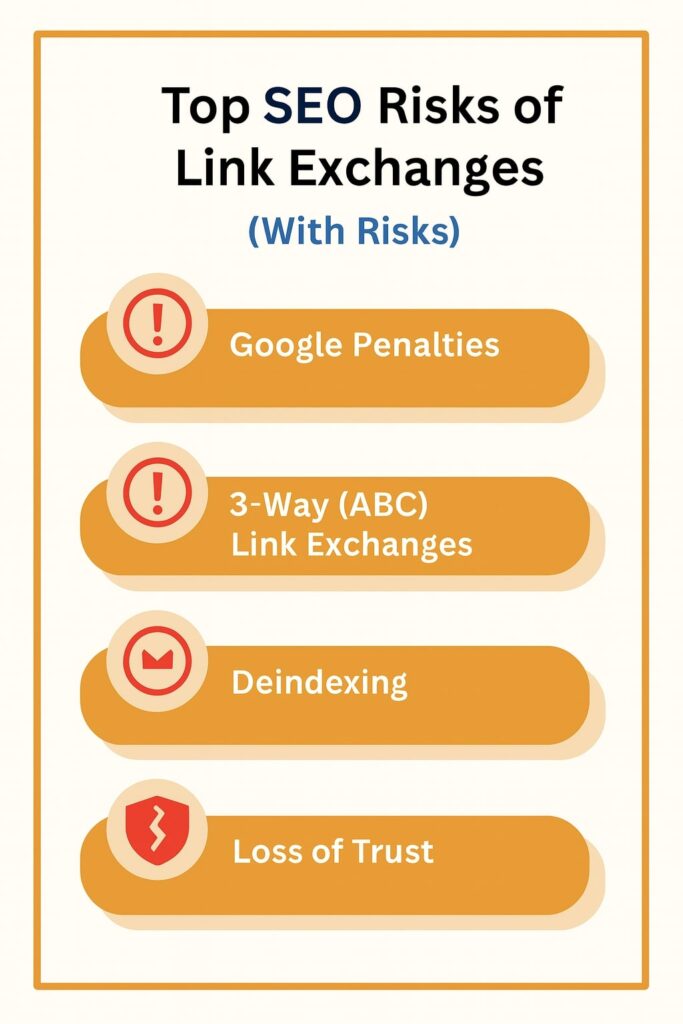
Watch out for these red flags before agreeing to any link swap:
- Exact-Match Anchor Repetition: If a site consistently asks for backlinks with money keywords (e.g., “buy backlinks,” “cheap SEO services”), it’s likely part of a manipulative scheme.
- No Editorial Oversight: Legitimate websites have editors who approve and format guest posts. If you’re told the content will be published “as-is,” that’s a warning sign.
- Unrelated Niche: Links from completely different industries (e.g., a casino blog linking to a SaaS tool) offer little contextual value and can signal artificial behavior to Google.
- Obvious Link Schemes: If the same author, formatting, or external links appear across dozens of sites, it’s likely part of a network or link farm.
- Automated or Mass Outreach: Offers that arrive via scraped contact forms or mass email tools with generic messages are rarely trustworthy.
- Private Blog Networks (PBNs): If a domain has high DR but no real traffic, fake branding, or links to hundreds of random sites—it may be a recycled expired domain used for PBN purposes.
- Paid Swaps Without Disclosure: Exchanging payment for a link without proper labeling as “sponsored” or “nofollow” violates Google’s policy and can lead to penalties.
✅ Final Tip
If the exchange seems too fast, too easy, or too off-topic, it probably isn’t worth it. SEO in 2025 rewards relevance, transparency, and editorial quality. Always vet your partners and follow best practices to avoid link-based penalties.
Smarter Alternatives to Direct Link Exchanges
Risky link exchanges may offer quick wins—but safer, long-term SEO growth comes from white-hat tactics that build authority, trust, and editorial value. These methods not only avoid penalties but also help establish your brand’s credibility in your niche.
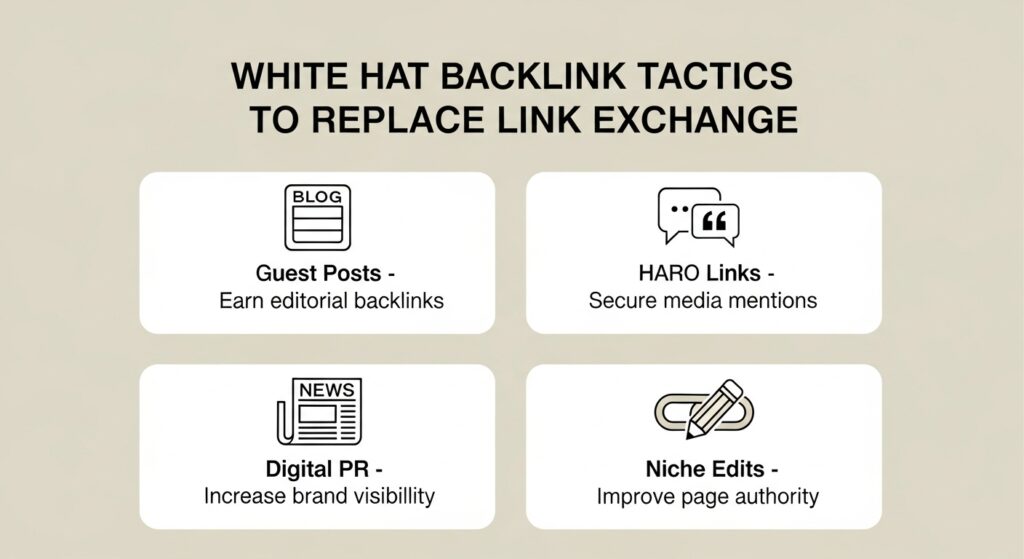
1. Use Digital PR for Editorial Backlinks
Earn backlinks by pitching expert commentary or original insights to journalists.
- Use platforms like HARO, Qwoted, SourceBottle, and Featured.
- Contribute quotes for news stories or industry roundups.
- Get published on authoritative domains like Forbes, TechCrunch, or niche-specific media.
- These links are high-authority, algorithm-proof, and build E-E-A-T (Expertise, Experience, Authority, Trust).
📌 Want to explore HARO further? Read our guide on HARO Backlinks.
2. Build Link Magnet Content Assets
Create content that naturally attracts backlinks from other websites, bloggers, and journalists.
- Format ideas: industry statistics pages, interactive tools, calculators, glossaries, and original research.
- Use “ultimate guides” and “how-to” hubs that become go-to resources in your space.
- Promote these assets via niche forums, Reddit, LinkedIn groups, and personalized outreach.
- Include visuals like infographics and data charts to boost shareability and embed potential.
💡 Example: A B2B SaaS company that publishes a “2025 SEO Tools Comparison Chart” may earn dozens of organic backlinks over time.
3. Leverage Strategic Guest Posting (No Swaps)
Guest blogging still works—if done without expecting a link in return.
- Identify industry blogs that accept high-quality submissions.
- Pitch articles that offer unique insights or real data.
- Earn contextual backlinks in the body of your post, not just author bios.
- Avoid reciprocal patterns and prioritize editorial value.
📌 Learn more in our guide on guest posting strategies.
4. Turn Unlinked Brand Mentions into Links
Many websites may mention your brand but forget to link. Recover these opportunities easily.
- Set up alerts using tools like Ahrefs Content Explorer, Google Alerts, or BrandMentions.
- Reach out and ask for a link back to the specific page or homepage.
- These links are typically easy to secure and highly relevant.
💡 Pro tip: Prioritize mentions on domains with good DR and existing traffic.
Key Takeaway
Modern SEO doesn’t require risky swaps. Use strategies like digital PR, content assets, and guest features to earn links naturally and future-proof your rankings.
Final Verdict: Are Backlink Exchanges Still Worth It in 2025?
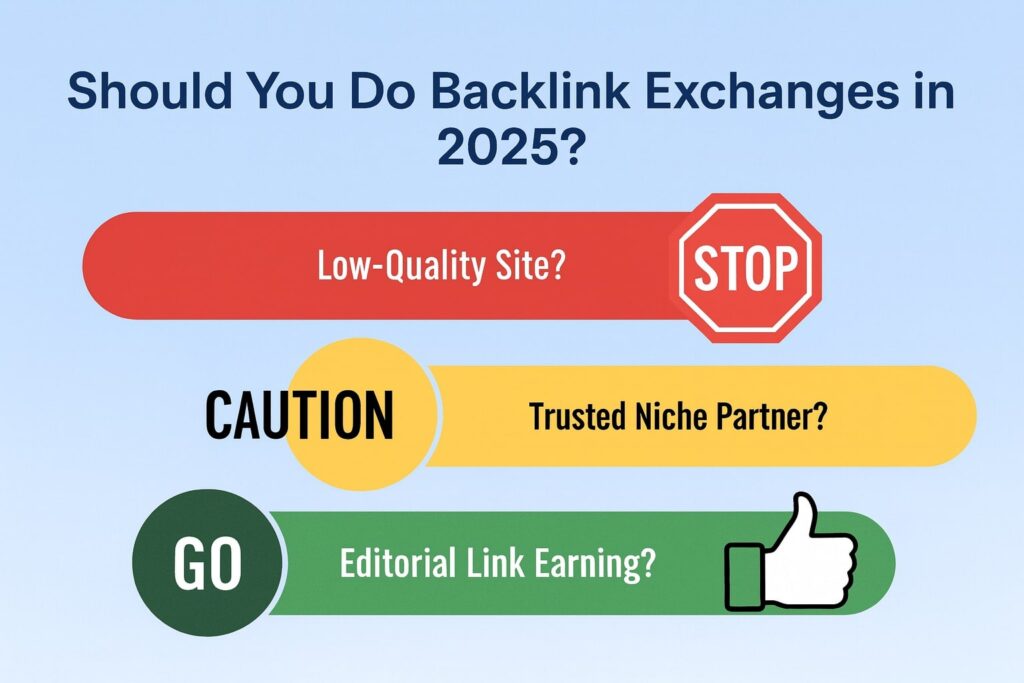
In conclusion, backlink exchanges remain a viable SEO tactic when used selectively, transparently, and with editorial relevance. Links placed in high-quality, niche-aligned content can still provide value, but careless or manipulative swaps pose serious risks.
Search engines now prioritize user intent, topical context, and natural link patterns. Relying solely on reciprocal links or automated exchanges can harm long-term performance. Safer, more effective strategies include digital PR, linkable content assets, guest posting, and brand mention recovery.
Building authority in 2025 requires trust, quality, and strategy—not shortcuts.
Need a secure and scalable backlink plan that follows Google’s standards? Book your free strategy call with T-RANKS today.
FAQs About Backlink Exchanges in 2025
1. Are reciprocal backlinks harmful for SEO?
Only when done for SEO manipulation. If reciprocal links are created purely to pass PageRank, especially with exact-match anchors or irrelevant content.They may be devalued or penalized. Natural, editorially placed reciprocal links between related sites are generally safe.
2. What is the safest way to exchange backlinks?
Use niche-relevant, in-content links embedded in high-quality editorial content. Avoid sidebars, footers, or link lists. Space exchanges over time, diversify anchor text, and ensure both parties publish genuinely valuable content.
3. Does Google penalize all link exchanges?
No. Google targets excessive, unnatural, or manipulative link exchanges. Editorial links—based on real collaboration or user value—are generally tolerated, even if reciprocal.
4. Can guest post swaps cause SEO issues?
They can if not handled carefully. Swapping guest posts with the same structure, anchors, or timing signals a pattern. To stay safe, guest posts should vary in format, add original value, and be published on topically aligned sites.
5. What metrics should I check before accepting a link exchange?
Focus on DR/DA scores, consistent organic traffic, low Spam Score, and strong Trust Flow. Make sure the anchor text is varied and outbound links are limited and relevant. Avoid sites with low traffic, spammy patterns, or unrelated content.
6. Are 3-way link swaps safer than direct exchanges?
Structurally yes, but they can still be detected. If your site links to Site B, which links to Site C, which links back to you—Google may still identify the pattern using link graph analysis. Intent and editorial quality still matter.
7. How many reciprocal links are considered risky?
There’s no fixed number. What matters is the proportion and pattern within your link profile. If most of your links come from obvious exchanges, it may raise flags—even if the number is small.
8. What are safer alternatives to backlink exchange?
Digital PR (HARO, Qwoted, SourceBottle)
Linkable assets (tools, glossaries, stats pages)
Brand mention recovery
Manual outreach to authoritative blogs
Podcast guesting or expert roundups
9. Can link exchanges still improve rankings in 2025?
Yes—if done transparently and sparingly. Strategic link exchanges between relevant, quality sites with useful content can still pass SEO value when executed naturally.
